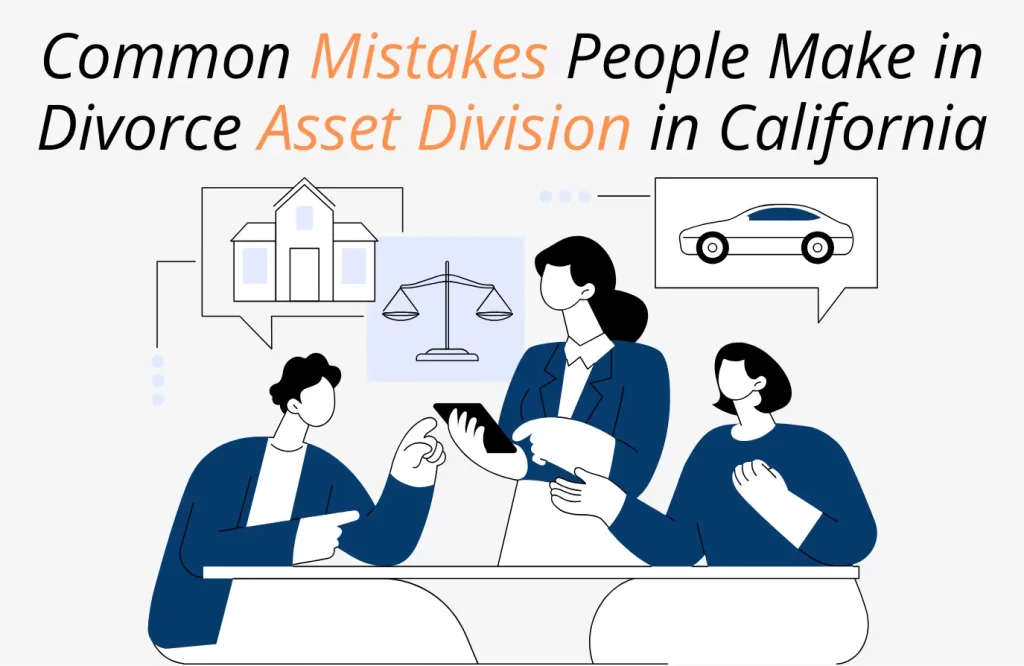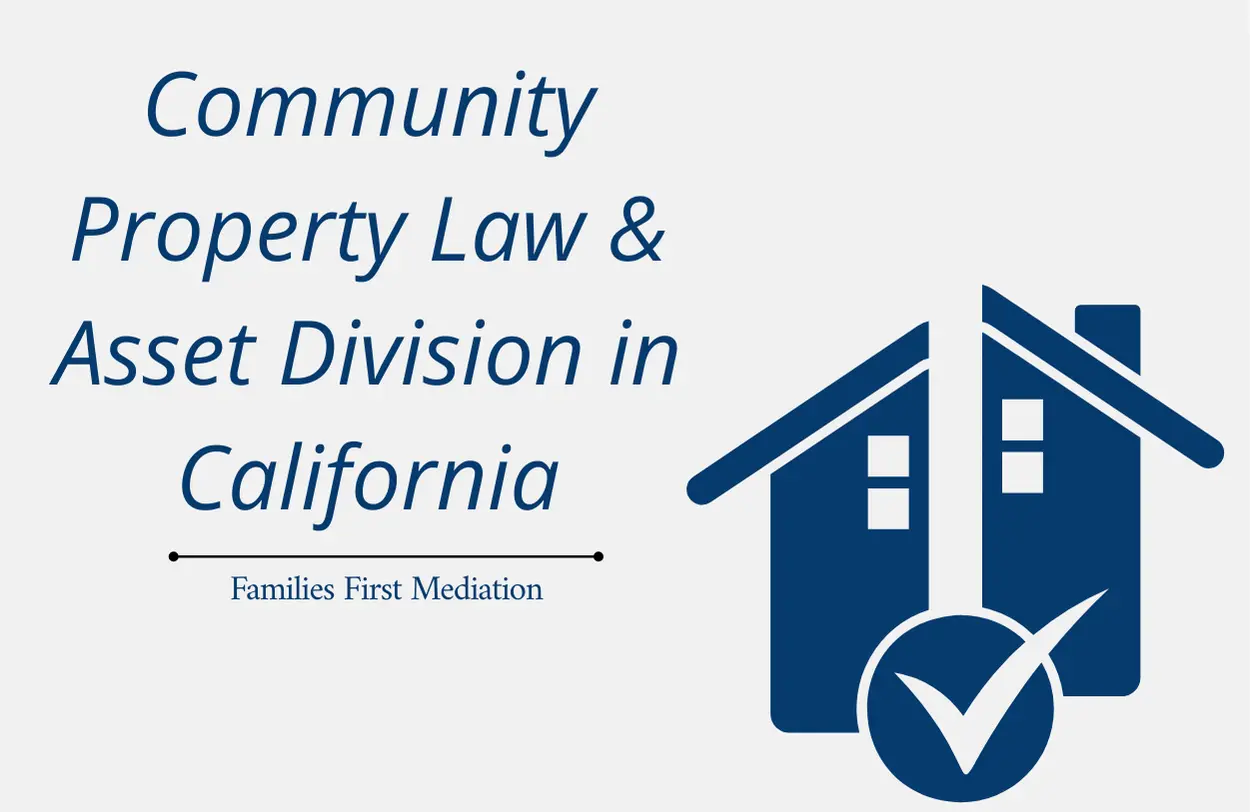Providing Divorce Mediation Services Throughout California
Providing Divorce Mediation Services Throughout California
Home » Divorce and Family law Blog » 9 Asset Division Mistakes Californians Often Make in Divorce

Dina Haddad and her team provide expert mediation services for Californians. If you want help related to any family law issue, call us or book a consult.
Going through a divorce in California is like a financial minefield. One misstep and you can unintentionally lose more of your financial assets.
California is a community property state, which means your assets and debts are split 50/50. Still, costly mistakes can lead to wrongful losses and penalties from improper property and asset classification. Preparation can avoid disputes and mistakes.
Divorce mediation allows couples to fairly and expeditiously divide property without going to court.
Experts such as Dina Haddad (who has been in the divorce business for over two decades) and Elizabeth Stephens (a Certified Divorce Financial Analyst, CDFA) can assist you with classifying your assets, pensions and business valuations.
Schedule a FREE Divorce Mediation Consult and opportunity to talk with a divorce and financial mediator.

In California, community property means all assets and debts acquired by either spouse during the period of a marriage. Community property applies regardless of which spouse earned or paid for the assets or debts during the marriage.
This includes:
Under California Family Code §760, these assets are typically split 50/50 in divorce.
Understanding what gets divided lets you know how much your wife is entitled to in a divorce, since not everything gets divided. Separate property includes:
But the problem is this: If you mix a separate asset with a community asset (for example, if you received an inheritance and put it into a joint bank account right before marriage), your spouse can claim half of the inheritance since now it is community property.
Many people assume:
For example, David received an inheritance of $100,000 during his marriage and used that inheritance to renovate their family home.
David did not keep receipts and was unable to trace his contributions to those reimbursements. At divorce proceedings, the court found that the inheritance was now community property, and he had lost his inheritance.
Tax and financial issues like this are just one reason that nine out of 10 people lose more than they should in divorce.
Do you want to avoid these issues and expensive divorce costs? Check our blog through the link.
Divorce financial missteps can trigger legal penalties, unfair losses, and years of regret. California courts are not sympathetic to ignorance—what you don’t know can hurt you.
By understanding these nine mistakes, you will be in a better position to protect your property rights and speed up your divorce process.

Many divorcing couples assume that property that was acquired before the marriage remains separate, specifically under California law, which is incorrect.
In California, you must have clear documentation that shows an asset is separate property.
Suppose you commingle an asset, even partially (such as putting an inheritance in a joint account or using a salary earned during marriage to pay a mortgage for separate property).
In that case, it will likely be classified as community property after that.
Normally, the spouse claiming that the property is separate must prove it is a separate asset.
If you do not have records, such as the deed before marriage, bank statements, gift letters, etc., the judge will usually assume it is a community property asset.
This mistake commonly costs spouses 50% of assets they believed were protected, particularly affecting inherited wealth and pre-marital investments.
Attempting to conceal assets in an offshore bank account, cryptocurrency, or reporting incorrect values regarding your collections or business interests does not end well.
California Family Code §1101 gives judges authority to award 100% of hidden assets to the other spouse, plus attorney fees.
Concealed assets are generally easy to find with taxes, lifestyle & spending analysis, and electronic paper trails by forensic accountants.
Even unintended omissions due to poor record-keeping or documentation may be viewed as concealing assets.
The financial and legal consequences, including potential allegations of perjury, far outweigh every instance of an apparent gain of concealing assets.
Disclose completely, with proper documentation to protect yourself against frivolous accusations of concealing assets, while obtaining a fair distribution of all marital property.
Dividing retirement accounts, investment properties, or stock options without considering tax consequences can reduce their value by
20–40%.
Withdrawals from traditional 401(k)s are taxed as income and may trigger a 10% early withdrawal penalty.
Capital gains taxes apply to appreciated assets when sold or transferred. Tax-free exchanges under IRC §1041 have strict timing rules.
The after-tax value of assets should guide negotiations, for example, $100,000 in a traditional IRA is not equivalent to $100,000 in a Roth IRA or in cash. Smart use of QDROs and careful timing of transfers can preserve thousands in potential tax savings.
California treats marital debts like assets – all obligations during marriage are split equally, even if one spouse borrowed the money or accumulated the debt on a credit card. Debt divides equally.
Credit card debt, personal loans, tax obligations, and possible lawsuits must all be accounted for in the division. Many people only focus on assets and forget that they will have to assume responsibility for debts after they break up.
Note that creditors have the right to pursue both for joint debts, whether or not a couple splits the bill with a divorce decree.
If you did not close those joint accounts, your ex-spouse could be running up new credit card balances for which you would still be legally responsible.
Proper debt division requires paying off or refinancing all joint obligations before finalizing the divorce to prevent future financial entanglement and damage to credit scores.
Business interests, stock options, royalties, and professional practices will require unique valuations, not just simple appraisals.
The most important aspect of valuing business success includes factors like goodwill, future earning potential and marketability discounts.
Valuations for stock options include other rules depending on whether the shares are vested or unvested.
It is customary for spouses to accept valuations without any independent assessment; therefore, they risk losing hundreds of thousands of dollars of equity.
In addition, forensic accountants will assess the capitalization rates on rental properties, discount cash flows for valued businesses, and Black-Scholes equations for stock options. These valued capital assets are typically the most significant piece of marital wealth: however, they often get divided in simple equations that do not accurately value the shares.
This is why proper valuations are necessary, as they will help ensure you obtain an equitable asset for your piece of this ever-increasing, appreciating asset.
The emotional consequences of divorce will drive many people to settle for issues they would never have settled for if they were in a more stable state of mind.
However, the divorce agreement you draft in California is not easy to modify later.
Important factors such as future education expenses, cost-of-living increases in support payments, and overall business buyout provisions require careful drafting and consideration.
Rushed divorce negotiations constantly overlook long-term tax implications, inflation variables, and income levels.
What seems fair today in your divorce settlement can result in financial deadweight in five years.
Consider various scenarios with financial professionals to help avoid regret regarding asset division, support amounts, and other life-altering financial obligations that will govern your new reality after divorce.
Divorce automatically revokes certain estate planning documents in California, but not all documents.
While your ex-spouse is disinherited from your will, they remain the beneficiary on your retirement accounts, life insurance policies, and POD accounts.
If you fail to update your beneficiary designations, those accidental inheritances could happen to your ex-spouse, even decades later.
Similarly, your powers of attorney and health care directives should be updated to remove your ex-spouse’s powers.
Your entire estate plan should be updated to include new beneficiaries, new guardians for any minor children, and your wishes regarding the distribution of your assets.
This process typically comes up during a crisis when you are not able to make any changes, leaving critical decisions to the wrong people.
California is a community property state, but the idea of equal 50/50 division has many exceptions and negotiation options.
Courts have allowed unequal division, depending on a spouse’s earning capacity, the length of the marriage, and one spouse’s separate property contributions to community assets.
There are many other creative options, such as asset trades (e.g., spouses taking less alimony to keep the family home) or postponing the distribution of assets to better accommodate both parties’ needs.
Many individuals reach a 50/50 division without considering alternatives that could help foster both parties’ financial stability after divorce.
Skillful mediators are able to develop creative options that build from a 50/50 division and fulfil both parties’ financial security while also addressing the emotional attachment others have with certain items.
Learn More: How to Legally Avoid Paying Alimony in California?
Divorce can change many aspects of your financial picture—tax filing status, cash flow, insurance needs and retirement planning all need to be dealt with immediately.
In many cases, people do not change their budgets for single-income living or account for new expenses like individual health insurance.
Support payments can affect taxes differently depending on whether they’re deductible, non-deductible, or tax-exempt.
The intended retirement contributions may need to increase to account for the divided accounts. It is also important to update titles, registration of vehicles/cards, and additional legal documents to limit future issues.
Creating a post-divorce financial plan is an organized way to keep track of these changes so that you don’t have a cash-flow crisis.
Putting it down on paper will help you ensure that you do not forget essential adjustments that you need to make to maintain your current level of financial sustainability and viability for your new life.
For high-asset divorces, the right professional team makes all the difference. A Certified
Divorce Financial Analyst, like Elizabeth Stephens, and an experienced mediator can bring financial knowledge and negotiation skills to your divorce to help you protect your wealth.
They will help you by:
Preparation is key to any divorce. To assist the professionals, gather 3-5 years of records, financial documents, and debt documentation such as tax returns, bank records, and so on.
Full disclosure is necessary for divorces, and it is always better to be completely transparent to avoid legal penalties for undisclosed assets.
Our free Divorce Asset Checklist ensures nothing gets overlooked. With expert guidance, you can achieve a fair division while maintaining control over the process.
Schedule your FREE Asset Division Consult today to get started!
Mistakes with divorce asset division—from misidentifying property to not considering taxes—can cost you dearly.
The best way to protect your money is preparation, full financial disclosure, and help from a mediator or CDFA. So don’t leave your financial future up to chance.
Schedule a FREE Divorce Mediation Consultation with our divorce experts today for a fair settlement.
Related: 7 Reasons Gray Divorce Couples Should Choose Divorce Mediation
Smart asset division requires these five key considerations:
Protect your future by addressing each factor carefully.
Typically, higher earners face a greater financial impact due to asset division and support payments. However, without proper planning, either spouse can suffer significant losses, especially those who overlook complex assets or tax implications.